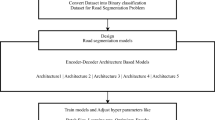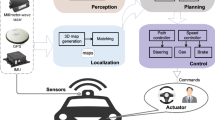Abstract
The indoor positioning for visually impaired people has influence on their daily life in unknown indoor environment. This study designs the robot that can assist the blind walking safety and navigate in indoor environment by a single camera. The sense classification is proposed to position the blind in indoor environment by proposed convolutional neural network framework and integrate the semantic segmentation to find the road surface through a depth camera to guide the blind walking. The proposed vision-based sense classification method is compared with the traditional WiFi triangular-positioning method, and the average error of x-y coordinate position result as (9.25,3.65) is better. From the experiment, the designed robot can help the visually impaired people to indoor navigation in unknown indoor environment.




















Similar content being viewed by others
Data availability
The datasets generated during and/or analyzed during the current study are available in the COCO and ADE20K repository, http://cocodataset.org/#home and https://groups.csail.mit.edu/vision/datasets/ADE20K/, separately.
References
ADE20K (n.d.) https://groups.csail.mit.edu/vision/datasets/ADE20K/. Accessed 28 Jun 2019
Badrinarayanan V, Kendall A, Cipolla R (2017) SegNet: a deep convolutional encoder-decoder architecture for image segmentation. IEEE Trans Pattern Anal Mach Intell 39(12):2481–2495
Bharathi S, Ramesh A, Vivek S (2012) Effective navigation for visually impaired by wearable obstacle avoidance system. In: 2012 International Conference on Computing, Electronics and Electrical Technologies (ICCEET), pp 956–958. https://doi.org/10.1109/ICCEET.2012.6203916
Bourbakis N, Kavraki D (2005) A 2D vibration array for sensing dynamic changes and 3D space for blinds’ navigation. In: Fifth IEEE Symposium on Bioinformatics and Bioengineering (BIBE’05), pp 222–226. https://doi.org/10.1109/BIBE.2005.1
Chen L, Papandreou G, Kokkinos I, Murphy K, Yuille AL (2018) DeepLab: semantic image segmentation with deep convolutional nets, atrous convolution, and fully connected CRFs. IEEE Trans Pattern Anal Mach Intell 40(4):834–848
COCO (n.d.) http://cocodataset.org/#home. Accessed 28 Jun 2019
Costilla-Reyes O, Namuduri K (2014) Dynamic Wi-Fi fingerprinting indoor positioning system. In: 2014 International Conference on Indoor Positioning and Indoor Navigation (IPIN), pp 271–280. https://doi.org/10.1109/IPIN.2014.7275493
Dakopoulos D, Boddhu SK, Bourbakis N (2007) A 2D Vibration array as an assistive device for visually impaired. In: 2007 IEEE 7th International Symposium on BioInformatics and BioEngineering, pp 930–937. https://doi.org/10.1109/BIBE.2007.4375670
Du Y, Czarnecki WM, Jayakumar SM, Farajtabar M, Pascanu R, Lakshminarayanan B (2020) Adapting auxiliary losses using gradient similarity. https://doi.org/10.48550/arXiv.1812.02224
El Lahib M, Tekli J, Issa YB (2018) Evaluating Fitts’ law on vibrating touch-screen to improve visual data accessibility for blind users. Int J Human-Comput Stud 112:16–27, ISSN 1071-5819,. https://doi.org/10.1016/j.ijhcs.2018.01.005
Girshick R, Donahue J, Darrell T, Malik J (2014) Rich feature hierarchies for accurate object detection and semantic segmentation. In: 2014 IEEE Conference on Computer Vision and Pattern Recognition, pp 580–587. https://doi.org/10.1109/CVPR.2014.81
Hart P, Nilsson NJ, Raphael B (1968) A formal basis for the heuristic determination of minimum cost paths. IEEE Trans Syst Sci Cybern 4:100–107
Hayat S, Kun S, Tengtao Z, Yu Y, Tu T, Du Y (2018) “A deep learning framework using convolutional neural network for multi-class object recognition,” 2018 IEEE 3rd international conference on image, vision and computing (ICIVC), Chongqing, pp. 194–198
He K, Zhang X, Ren S, Sun J (2016) Deep residual learning for image recognition. In: 2016 IEEE Conference on Computer Vision and Pattern Recognition (CVPR), pp 770–778. https://doi.org/10.1109/CVPR.2016.90
Hsieh YZ, Lin SS, Xu FX (2020) Development of a wearable guide device based on convolutional neural network for blind or visually impaired persons. Multimed Tools Appl 79:29473–29491. https://doi.org/10.1007/s11042-020-09464-7
Kumar N, Vámossy Z, Szabó-Resch ZM (2016) Heuristic approaches in robot navigation. In: 2016 IEEE 20th Jubilee International Conference on Intelligent Engineering Systems (INES), pp 219–222. https://doi.org/10.1109/INES.2016.7555123
Lee N, Han D (2017) “Magnetic indoor positioning system using deep neural network,” 2017 international conference on indoor positioning and indoor navigation (IPIN), Sapporo, pp. 1–8
Lin G, Milan A, Shen C, Reid I (2017) RefineNet: multi-path refinement networks for high-resolution semantic segmentation. In: 2017 IEEE conference on computer vision and pattern recognition (CVPR), Honolulu, HI, pp 5168–5177
Naga Srinivasu P, Balas VE (2021) Self-learning network-based segmentation for real-time brain M.R. images through HARIS. PeerJ Comput Sci 2(7):e654. https://doi.org/10.7717/peerj-cs.654 PMID: 34435099; PMCID: PMC8356652
Redmon J, Farhadi A (2017) YOLO9000: Better, Faster, Stronger. In: 2017 IEEE conference on computer vision and pattern recognition (CVPR), Honolulu, HI, pp 6517–6525
Redmon J, Farhadi A (2018) “Yolov3: An incremental improvement”, CoRR, vol. abs/1804.02767
Redmon J, Divvala S, Girshick R, Farhadi A (2016) “You only look once: unified, real-time object detection,” 2016 IEEE conference on computer vision and pattern recognition (CVPR), Las Vegas, NV, pp. 779–788
Ren S, He K, Girshick R, Sun J (2017) Faster R-CNN: towards real-time object detection with region proposal networks. IEEE Trans Pattern Anal Mach Intell 39(6):1137–1149
Santos ADPD, Suzuki AHG, Medola FO, Vaezipour A (2021) A systematic review of wearable devices for orientation and mobility of adults with visual impairment and blindness. IEEE Access 9:162306–162324. https://doi.org/10.1109/ACCESS.2021.3132887
Shelhamer E, Long J, Darrell T (2017) Fully convolutional networks for semantic segmentation. IEEE Trans Pattern Anal Mach Intell 39(4):640–651
Sokic E,Ferizbegovic M,Zubaca J,Softic K, Ahic-Djokic M (2015) “Design of Ultrasound-based Sensory System for environment inspection robots”, International symposium ELMAR (ELMAR), Zadar,Croatia ,28–30 September
Sonali KK, Dharmesh HS, Nishant MR (2010) Obstacle avoidance for a mobile exploration robot using a single ultrasonic range sensor. INTERACT-2010, pp 8–11. https://doi.org/10.1109/INTERACT.2010.5706156
Srinivasu PN, Bhoi AK, Jhaveri RH et al (2021) Probabilistic deep Q network for real-time path planning in censorious robotic procedures using force sensors. J Real-Time Image Proc 18:1773–1785. https://doi.org/10.1007/s11554-021-01122-x
Swaminathan R, Nischt M, Kuhnel C (2008) Localization based object recognition for smart home environments. In: 2008 IEEE International Conference on Multimedia and Expo, pp 921–924. https://doi.org/10.1109/ICME.2008.4607586
Tekli J, Issa YB, Chbeir R (2018) Evaluating touch-screen vibration modality for blind users to access simple shapes and graphics. Int J Human-Comput Stud 110:115–133, ISSN 1071-5819,. https://doi.org/10.1016/j.ijhcs.2017.10.009
Wang P et al. (2018) “Understanding convolution for semantic segmentation,” 2018 IEEE winter conference on applications of computer vision (WACV), Lake Tahoe, NV, pp. 1451–1460
Xu Y, Wang Y, Ma L (2010) “A Novel WLAN Indoor Positioning Algorithm Based on Positioning Characteristics Extraction,” 2010 Fourth international conference on genetic and evolutionary computing, Shenzhen, pp. 134–137
Zhao H, Shi J, Qi X, Wang X, Jia J (2017) Pyramid scene parsing network. In: 2017 IEEE conference on computer vision and pattern recognition (CVPR), Honolulu, HI, pp 6230–6239
Acknowledgments
This paper was partly supported by Ministry of Science and Technology, Taiwan, under MOST 110-2221-E-019 -051 -, 109-2221-E-019 -057 -, 110-2634-F-019 -001 – and 110-2634-F-008 -005 -.
Author information
Authors and Affiliations
Corresponding author
Ethics declarations
Conflict of interest
The authors declare no conflict of interest.
Additional information
Publisher’s note
Springer Nature remains neutral with regard to jurisdictional claims in published maps and institutional affiliations.
Rights and permissions
Springer Nature or its licensor (e.g. a society or other partner) holds exclusive rights to this article under a publishing agreement with the author(s) or other rightsholder(s); author self-archiving of the accepted manuscript version of this article is solely governed by the terms of such publishing agreement and applicable law.
About this article
Cite this article
Hsieh, YZ., Ku, XL. & Lin, SS. The development of assisted- visually impaired people robot in the indoor environment based on deep learning. Multimed Tools Appl 83, 6555–6578 (2024). https://doi.org/10.1007/s11042-023-15644-y
Received:
Revised:
Accepted:
Published:
Issue Date:
DOI: https://doi.org/10.1007/s11042-023-15644-y




